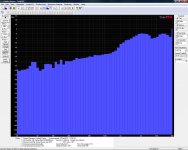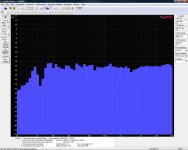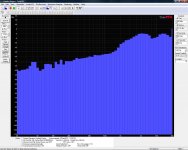I have been playing around with TrueTRA, measuring my DIY speakers and I could sure use some input from some of you experts.  The speakers I'm measuring are 2way, MTM based on the Aria R1 by Zalytron, but modified with the help of Orca Designs. It has 2 Focal 5.25's and the Raven 1" ribbon tweeter, vented, with curved sides. I ran measurements using a Behringer shotgun mic, in my listening room. As you can see from the first graph I'm getting a 5dBu dip at about 8k when measured at 1" centered on the tweeter, which goes away at 112". I get this same dip on both speakers. Any ideas? The second graph is the same speaker at 112". Any feedback is greatly appreciated.
The speakers I'm measuring are 2way, MTM based on the Aria R1 by Zalytron, but modified with the help of Orca Designs. It has 2 Focal 5.25's and the Raven 1" ribbon tweeter, vented, with curved sides. I ran measurements using a Behringer shotgun mic, in my listening room. As you can see from the first graph I'm getting a 5dBu dip at about 8k when measured at 1" centered on the tweeter, which goes away at 112". I get this same dip on both speakers. Any ideas? The second graph is the same speaker at 112". Any feedback is greatly appreciated.
Attachments
My SWAG is it's a 1/2 WL reflection dip [eigenmode] between the ribbon and mic, which at 112" it appears to be summing with the ~60 Hz dip.GM
Thanks for the reply. Could you dumb it down a bit for me? How does the reflection work? I take it that since it is some kind of interaction between the mic and the ribbon it would change when the mic is moved back. And that is why there is no dip when the mic is moved back. Does that make any sense or am I misunderstanding it completely?
The 1" (=2,5cm) or even 1' (=30cm) distance is "nearfield". Then with the microphone positioned at the tweeter axis naturally "boosts" the output of tweeter. If distance to woofers is exactly same there will be now lobing seen. The dip at 8kHz comes from the nearness - that F oscillating like GM said. Measure several times, increase mic distance and you will see the dip going down in Hz.
The 112" (=2,8m) distance is "far-far field" practically room response with all the reflections and modes, unless done outdoor or in an airplane hangar. Usually when measuring indoors 1-1,5m distance and the speaker on a stand in the middle of the room >2m from walls is enough for the drivers to sum well together and keeping floor, ceilin, wall etc.reflections tamed.
RTA is ok for room response analysis, but speaker nearfield measurements should be done with some more sophisticated programs like REW, ARTA, Holmimpule, LMS or like.
The 112" (=2,8m) distance is "far-far field" practically room response with all the reflections and modes, unless done outdoor or in an airplane hangar. Usually when measuring indoors 1-1,5m distance and the speaker on a stand in the middle of the room >2m from walls is enough for the drivers to sum well together and keeping floor, ceilin, wall etc.reflections tamed.
RTA is ok for room response analysis, but speaker nearfield measurements should be done with some more sophisticated programs like REW, ARTA, Holmimpule, LMS or like.
Last edited:
Thanks for the education guys. It's much appreciated. Is the lobing error caused by the interaction of the waves from the tweeter and the woofers or just from the position of the tweeter in relation to the woofers? Or is it just the position of the mic? I ask because this graph is the same tweeter with the woofers disconnected and the mic 2.54cm from the tweeter. You can see I still get the lobing at 8k. You probably realize this already but the speakers are a "D'Appolito" configuration.
Attachments
Yes, it i sthe distance of the microphone to the driver's membrane. (½ of it means nulling - a dip in the graph.
With two woofers playing (or two seakers simultaneously farfield) You will get distance-difference determined "lobing" in response ie. several peaks and dips. This is actually happening also in the region of crossing passbands around crossover frequency in any non-coaxial speaker.
Here is a link to speaker measurements to start with Loudspeaker measurement - Wikipedia, the free encyclopedia
Check also this Measuring Loudspeakers, Part One | Stereophile.com
A video http://youtu.be/oa2RC_DSPOk and http://youtu.be/j77VKw9Kx6U
With two woofers playing (or two seakers simultaneously farfield) You will get distance-difference determined "lobing" in response ie. several peaks and dips. This is actually happening also in the region of crossing passbands around crossover frequency in any non-coaxial speaker.
Here is a link to speaker measurements to start with Loudspeaker measurement - Wikipedia, the free encyclopedia
Check also this Measuring Loudspeakers, Part One | Stereophile.com
A video http://youtu.be/oa2RC_DSPOk and http://youtu.be/j77VKw9Kx6U
Last edited:
- Status
- This old topic is closed. If you want to reopen this topic, contact a moderator using the "Report Post" button.


